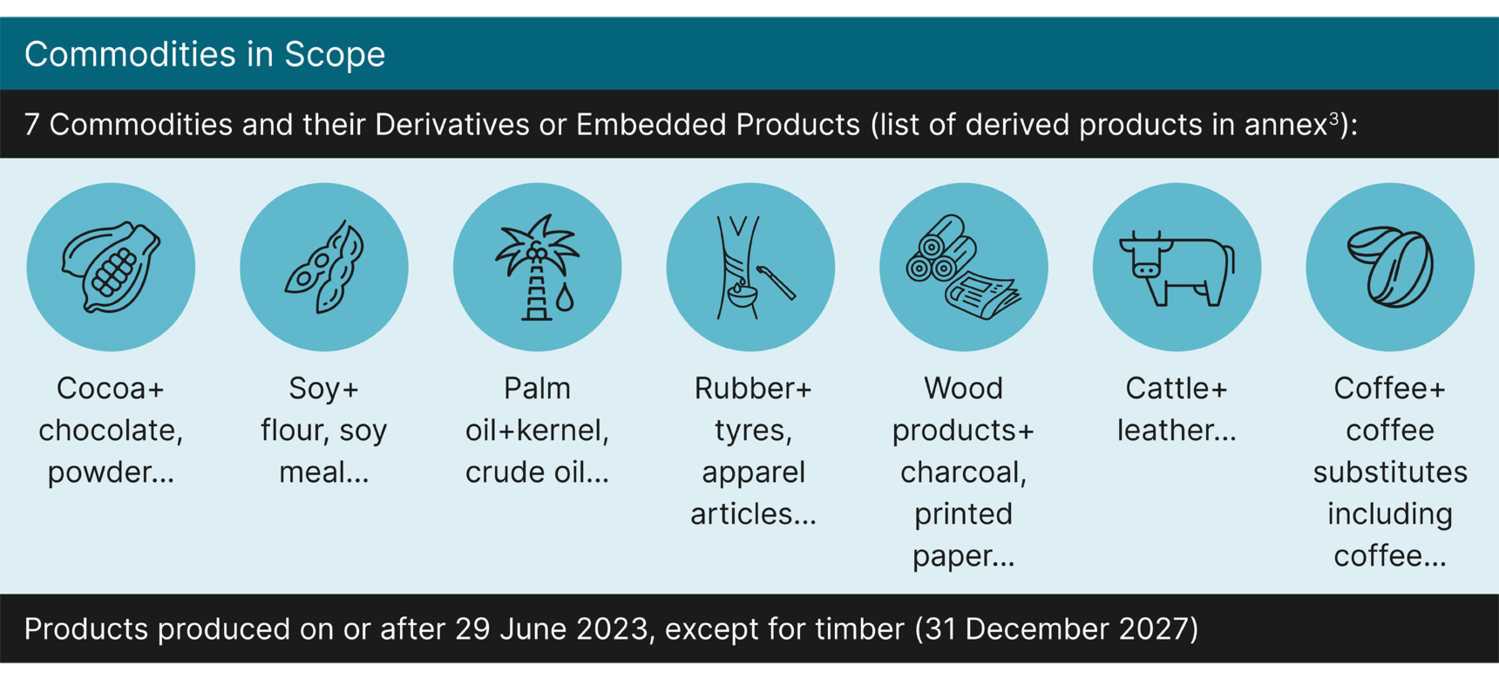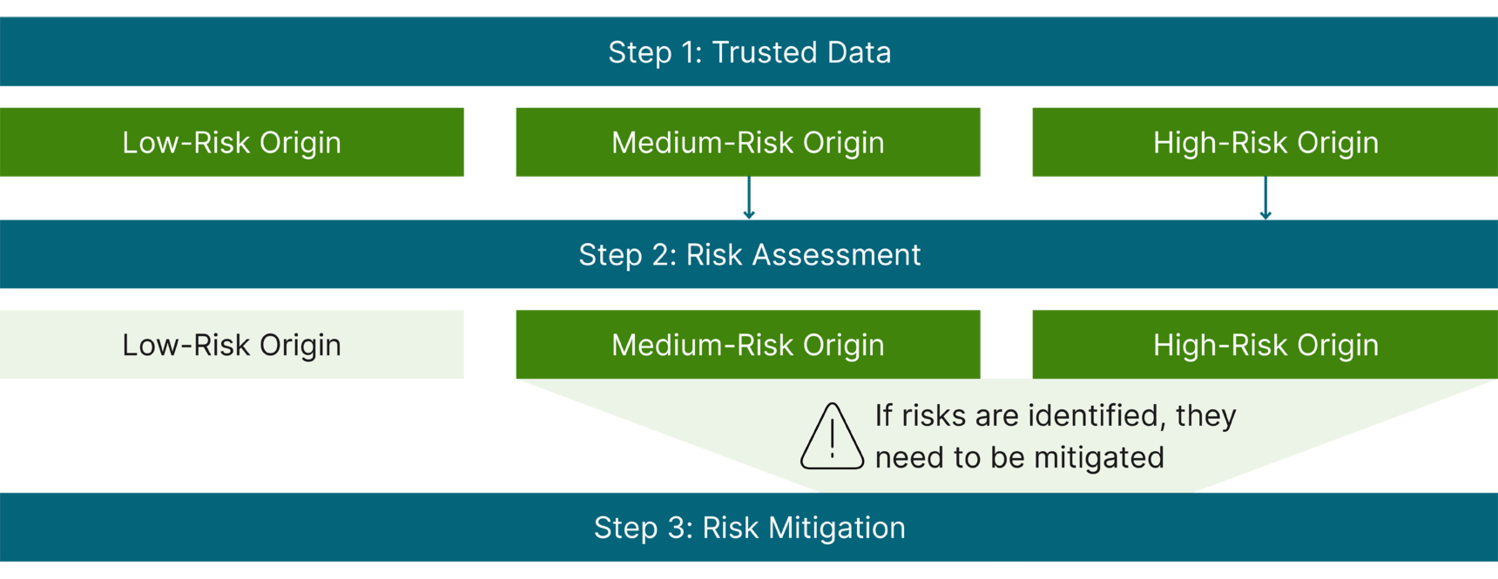EU imports between 1990-2008 accounted for 36% of global crop products linked to deforestation1. To mitigate those impacts, the European Commission introduced the EU Deforestation Regulation (EUDR) as an important part of the EU Green Deal.
The EU Deforestation Regulation2 came into force on 29 June 2023, and aims to guarantee that selected products EU citizens consume do not contribute to deforestation or forest degradation. It covers seven main commodities and products that originate from or are a part of these commodities. This blog provides an overview of the contents of the regulation and preparatory steps for compliance for companies established in the EU.
What is in Scope?
Companies importing the products listed in the Regulation2 to the European market need a proof of origin (geolocation of all plots of land) and proof that the imported good did not cause any deforestation and forest degradation after 31 December 2020. Additionally, sourcing and production of goods needs to comply with relevant local regulations, going beyond environmental protection, including, for instance, land-use rights.
What is the Due Diligence Process?
The robustness of the risk assessment depends on the sourcing country and associated sustainability risk profile (low-, standard-, or high-risk). For products from standard-risk and high-risk countries, companies need to conduct a risk assessment, assessing the origin against 14 risk criteria, including environmental and human rights. Any identified risk needs to be mitigated before goods can be imported to the EU.
Who Needs to Comply and By When?
The EUDR covers both the commercial activities of operators (importing the goods on the EU market) and traders (commercializing, e.g., processing, distributing, and selling already imported goods).
Actors further down the supply chain may refer to due diligence performed earlier in the supply chain, though they may still retain legal responsibility in the event of a breach of the regulation.
- Non-SMEs: 30 December 2024
- SMEs: 30 June 2025
- Exception: Timber products: 31 December 2027
In case of non-compliance, companies may face penalties and sanctions such as suspension or refusal of import or fines of up to 4% of company turnover within the EU. Additionally, scrutiny by private parties may also occur. The EUDR allows for the possibility for private parties, e.g., NGOs, to submit substantiated concerns.
Three Key EUDR Requirements Companies Need to Prepare for
1. Collecting the right data: A comprehensive understanding of the supply chain complexity is required to be able to assess the scope of goods falling under the due diligence process. Companies may need to ensure traceability down to farm-level for all products in scope of the regulation that are being placed on the market. A supplier engagement mechanism will be key for the data collection and ensuring compliance. Companies procuring the in-scope products from importers may need to include new requirements in their procurement processes.
2. Establishing a risk assessment:
The EUDR requires an ongoing, at least annual, risk assessment for imports from standard-risk and high-risk countries. The risk assessment criteria may require a deep understanding of country of origin, the supply chain, and historic events. Establishing a risk management and identifying reliable data sources for the risk assessment may be an essential tool to assist with this analysis.
3. Preparing for risk mitigation: Companies may need to set up an approach and strategy for adequate and proportionate risk mitigation measures in case risks have been identified. For this, capacity building and investments may be needed to enable the additionally required data collection and reporting. By establishing policies, controls, responsibilities, and procedures, and including them in the risk management process, companies can help react quickly to emerging risks.
Conclusion
The EUDR poses companies with global agricultural value chains active on the EU market with new challenges to increase supply chain traceability and risk management. It will not only be relevant for EU companies, but non-EU companies may also be asked by their customers to provide the necessary information. While the new data requirements call for significant additional efforts in supply chain management, the new traceability requirements could boost companies’ progress toward resilient and nature-positive value chains and unlock synergies between Scope 3 abatement and nature-risk and opportunities assessments.
How Guidehouse Can Help
Guidehouse can support your company in identifying your exposure to EUDR compliance, mapping your supply chain, setting up a data collection system, and a supplier engagement mechanism to obtain the needed information. As a next step, we can help you prepare for the risk assessment for medium- and high-risk countries and support you in developing a risk mitigation strategy. We work to leverage the synergies present between your ongoing data collection efforts for greenhouse gas accounting, forest, land, and agriculture targets, abatement roadmaps, Science Based Targets Network, and risk assessments in preparation for the Corporate Sustainability Reporting Directive or Taskforce on Nature-related Financial Disclosures.
Writers & Contributors
Wiktoria Beckman, Senior Consultant
Lina Fromme, Consultant
Michèle Koper, Director
Footnotes
| 1. “The Impact of EU Consumption on Deforestation: Comprehensive Analysis of the Impact of EU Consumption on Deforestation Final Report.” n.d. Accessed December 6, 2019. https://doi.org/10.2779/822269. |
| 2. “REGULATION (EU) 2023/1115 of the EUROPEAN PARLIAMENT and of the COUNCIL of 31 May 2023.” n.d. https://eur-lex.europa.eu/legal-content/EN/TXT/PDF/?uri=CELEX:32023R1115. |
| 3. Review of Union Market and the Export from the Union of Certain Commodities. 2023. Official Journal of the European Union, June. https://eur-lex.europa.eu/legal-content/EN/TXT/PDF/?uri=CELEX:32023R1115. |




